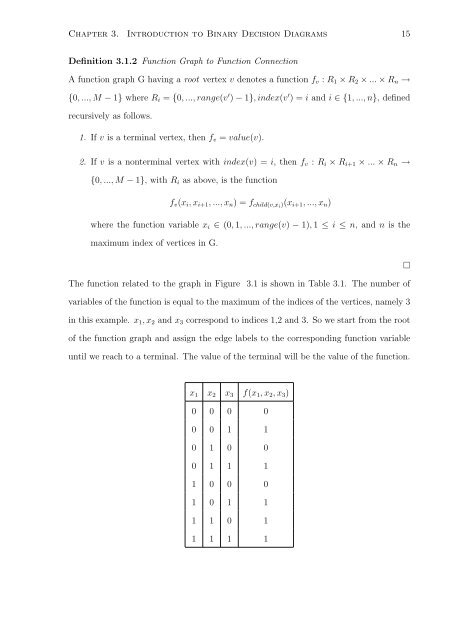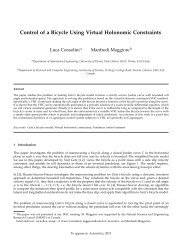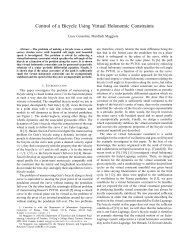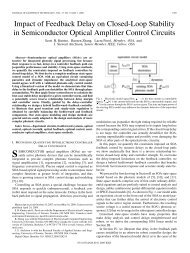State Based Control of Timed Discrete Event Systems using Binary ...
State Based Control of Timed Discrete Event Systems using Binary ...
State Based Control of Timed Discrete Event Systems using Binary ...
You also want an ePaper? Increase the reach of your titles
YUMPU automatically turns print PDFs into web optimized ePapers that Google loves.
Chapter 3. Introduction to <strong>Binary</strong> Decision Diagrams 15Definition 3.1.2 Function Graph to Function ConnectionA function graph G having a root vertex v denotes a function f v : R 1 × R 2 × ... × R n →{0, ..., M − 1} where R i = {0, ..., range(v ′ ) − 1}, index(v ′ ) = i and i ∈ {1, ..., n}, definedrecursively as follows.1. If v is a terminal vertex, then f v = value(v).2. If v is a nonterminal vertex with index(v) = i, then f v : R i × R i+1 × ... × R n →{0, ..., M − 1}, with R i as above, is the functionf v (x i , x i+1 , ..., x n ) = f child(v,xi )(x i+1 , ..., x n )where the function variable x i ∈ (0, 1, ..., range(v) − 1), 1 ≤ i ≤ n, and n is themaximum index <strong>of</strong> vertices in G.□The function related to the graph in Figure 3.1 is shown in Table 3.1. The number <strong>of</strong>variables <strong>of</strong> the function is equal to the maximum <strong>of</strong> the indices <strong>of</strong> the vertices, namely 3in this example. x 1 , x 2 and x 3 correspond to indices 1,2 and 3. So we start from the root<strong>of</strong> the function graph and assign the edge labels to the corresponding function variableuntil we reach to a terminal. The value <strong>of</strong> the terminal will be the value <strong>of</strong> the function.x 1 x 2 x 3 f(x 1 , x 2 , x 3 )0 0 0 00 0 1 10 1 0 00 1 1 11 0 0 01 0 1 11 1 0 11 1 1 1







